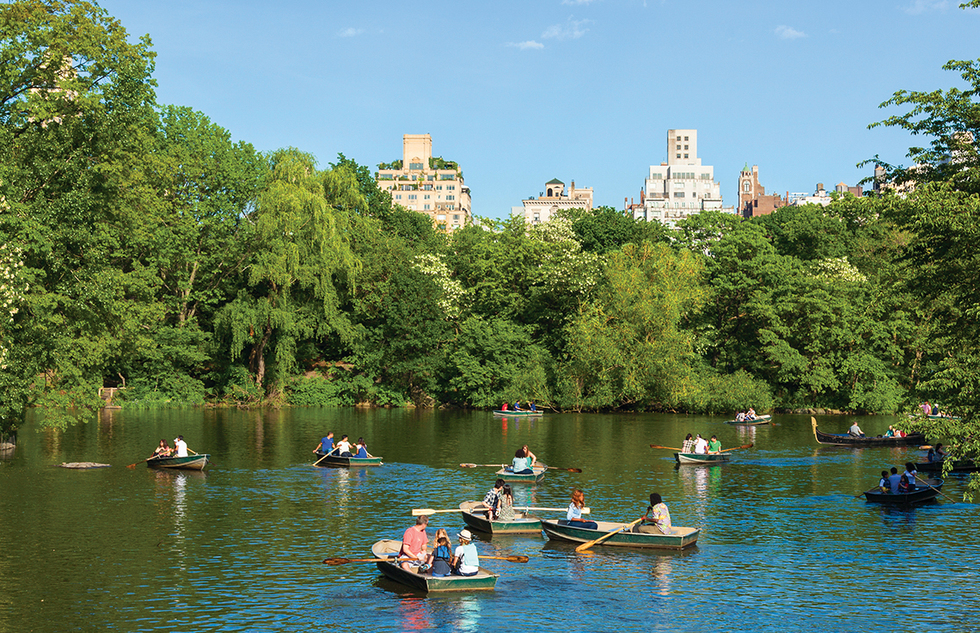Manhattan’s 843-acre green oasis is the yin to the city’s neon, concrete, and office tower yang. It serves as the city’s backyard, its concert hall, its daytime pick-up bar, and, in the summer, when dozens don bathing suits to soak up the rays, its green beach. The marvel of the park, besides its size (a full 6% of the total area of Manhattan), is its ability to provide just the right sort of experience for the myriad of very different personalities who think of it as their own. I think it’s that chameleon-like quality that makes it such an interesting place for visitors to tour. Seeing it from an outsider’s perspective, it’s much easier to recognize that the park is a great mirage and paradox.
Because, let’s face it, very little here is natural. Every tree, every shrub, every lake, and most of the rolling hills were designed, planted, or blasted into existence by landscape architects Frederick Law Olmsted and Calvert Vaux back in the 1850s, and their efforts still shape our experiences today. These two geniuses took a 2 1/2-mile tract of swampland, farms, and suburban towns and created an Arcadia that had no resemblance whatever to what had come before. Below the park, 95 miles of drainage pipes were installed, many to both fill and periodically empty the four lakes that were created; at ground level the site was transformed using six million bricks, 65,000 cubic tons of gravel, 26,000 trees, and 250,000 shrubs. Even the dirt was imported; the natural topsoil was so poor that 500,000 cubic feet of topsoil was shipped in from New Jersey. As Olmsted once wrote, “Every foot of the park, every tree and bush, every arch, roadway and walk, has been fixed where it is with a purpose.”
And what was that purpose? No less than the health of the city. Those who rallied for its creation felt that it was crucial to create a place where New Yorkers could blow off steam and get away from the stresses of urban life. Moreover, Olmsted wanted to create a park that would be a bridge between classes. “There need to be places and time for re-unions,” Olmsted wrote, “[where] the rich and the poor, the cultivated and the self-made, shall be attracted together and encouraged to assimilate.” Though that didn’t happen when the park was first finished—it was too far from the homes of poor New Yorkers for them to visit it—that ideal was realized when the city itself began to wrap around the park, making it finally a true central park.
In your own strolls around the park, you’ll encounter three different types of landscapes: pastoral vistas such as the Sheep’s Meadow, which are meant to invoke a cultivated countryside; primitive portions where dense forestation shuts out any view of the city; and the promenade zones, which were once used by the city’s aristocracy as an extension of their parlors, a place to strut and be seen. An ideal visit here will include all three. I’ve created a relatively brief list of highlights, along with the activities you can engage in once in the park, that should allow you to do just that. Feel free to ignore the following list altogether and just wander the curving paths of the park, exploring its hidden nooks, surprise vistas, ball fields, and dog runs. There’s no right way to see or do this park.
Orientation & Getting There: The park runs from 59th Street (also known as Central Park South) at the south end to 110th Street at the north end, and from Fifth Avenue on the east side to Central Park West (the equivalent of Eighth Avenue) on the west side. A 6-mile rolling road, Central Park Drive, circles the park, and has a lane set aside for bikers, joggers, and in-line skaters. A number of transverse (crosstown) roads cross the park at major points—at 65th, 79th, 86th, and 97th streets—but they’re built down a level, largely out of view, to minimize intrusion.
A number of subway stops and lines serve the park, and which one you take depends on where you want to go. To reach the southernmost entrance on the west side, take an A, B, C, D, or 1 to 59th Street/Columbus Circle. To reach the southeast corner entrance, take the N or R to Fifth Avenue.
There’s now an app that will guide you around Central Park and comes complete with GPS should you get lost and need to find a nearby exit. Both Android- and iPhone-compatible, it’s created by the Park Service and downloadable from the App Store.






 About our rating system
About our rating system


